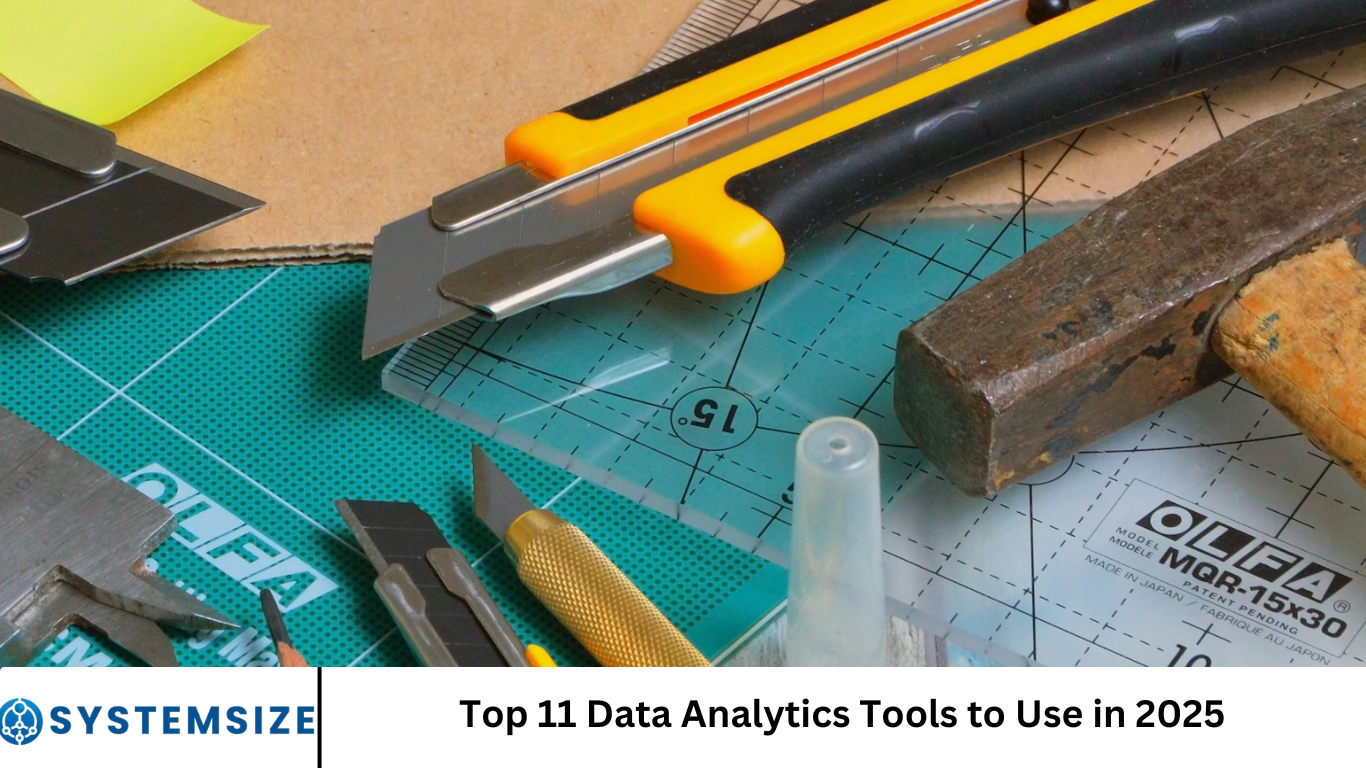In the rapidly evolving world of data science and business intelligence, staying ahead means equipping your team with the best tools. With massive volumes of data being generated every second, organizations need powerful data analytics tools to make sense of this information and drive smarter decisions.
In 2025, a new wave of tools, combining advanced AI, user-friendly interfaces, and seamless integration capabilities, is transforming the landscape of data analytics. Whether you’re a seasoned data scientist, a business analyst, or a startup founder, selecting the right data analytics tool is crucial. Here are the top 11 data analytics tools to use in 2025:
More Read: Boost IT Efficiency with Smart Storage Reports
1. Microsoft Power BI
Best for: Business Intelligence and Dashboarding
Power BI continues to dominate the analytics space in 2025 thanks to its tight integration with Microsoft products, intuitive dashboards, and real-time data capabilities. With enhanced AI-infused features and natural language querying, Power BI allows users to get insights faster and more accurately.
Key Features:
- Real-time dashboards and reporting
- Integration with Microsoft Excel, Azure, and Teams
- AI-powered data preparation and visualization
2. Tableau
Best for: Visual Analytics and Data Exploration
A long-time leader in data visualization, Tableau remains a favorite in 2025. Its powerful visualization engine, user-friendly drag-and-drop interface, and strong community support make it a go-to tool for exploring and presenting data.
Key Features:
- Real-time data analysis
- Integration with almost any data source
- Predictive analytics powered by Einstein AI (Salesforce)
3. Google Looker (Looker Studio)
Best for: Embedded Analytics and Cloud Integration
Backed by Google Cloud, Looker offers seamless cloud-native data analytics. It shines in embedded analytics, real-time dashboards, and customizable data experiences, making it ideal for cloud-first organizations.
Key Features:
- Native integration with BigQuery and other Google Cloud services
- Centralized data modeling with LookML
- Customizable, embedded analytics
4. Apache Superset
Best for: Open-Source BI and Developer-Centric Use
Apache Superset is gaining traction in 2025 for teams seeking open-source flexibility. It’s scalable, supports a wide range of SQL-speaking databases, and offers impressive visualization capabilities for a free tool.
Key Features:
- Extensible with plugins
- Rich data visualization
- Lightweight, cloud-native architecture
5. Qlik Sense
Best for: Associative Data Exploration
Qlik Sense’s associative engine allows users to explore data from multiple angles, helping to uncover hidden insights. In 2025, Qlik’s integration with AI and augmented analytics makes it a formidable tool for large enterprises.
Key Features:
- Self-service data discovery
- Smart search and AI-assisted insights
- On-premise and cloud deployments
6. Databricks
Best for: Data Science and Big Data Analytics
Databricks has become an essential platform for data engineers and scientists alike. Powered by Apache Spark, the Databricks Lakehouse architecture combines data lakes and warehouses for high-performance analytics.
Key Features:
- Unified data analytics platform
- Native support for ML and AI workflows
- Collaborative notebooks and Delta Lake support
7. IBM Cognos Analytics
Best for: Enterprise-Grade Business Intelligence
IBM Cognos has reinvented itself with more AI-driven features and improved user interfaces. In 2025, it remains relevant for organizations that need robust, scalable BI with enterprise governance.
Key Features:
- AI-infused data preparation and analysis
- Automated data discovery
- Report and dashboard sharing at scale
8. Sisense
Best for: Embedded Analytics and Custom Applications
Sisense is known for its powerful embedded analytics capabilities, enabling businesses to build custom analytics applications. It allows you to infuse intelligence into customer-facing apps without compromising performance.
Key Features:
- Cloud-native architecture
- In-chip technology for fast querying
- Extensible with APIs and plugins
9. Zoho Analytics
Best for: SMBs and Cost-Effective BI
Zoho Analytics is an excellent choice for small to mid-sized businesses looking for a cost-effective analytics solution. It offers a clean UI, automated insights, and great integration with other Zoho products.
Key Features:
- AI-powered analytics assistant (Zia)
- Drag-and-drop report creation
- Affordable pricing model
10. Alteryx
Best for: Data Preparation and Advanced Analytics
Alteryx is a favorite among data analysts who need to clean, blend, and prepare data before analysis. Its visual workflow interface makes advanced data prep and analytics accessible without coding.
Key Features:
- Code-free data preparation
- Built-in predictive analytics
- Integration with R and Python
11. SAP Analytics Cloud
Best for: Integrated Planning and Predictive Analytics
SAP Analytics Cloud integrates BI, planning, and predictive capabilities into one platform. For enterprises already using SAP products, it’s a natural choice in 2025 for data-driven decision-making.
Key Features:
- Unified platform for BI and planning
- Embedded machine learning
- Seamless SAP ecosystem integration
Choosing the Right Tool in 2025
When selecting a data analytics tool in 2025, consider the following factors:
- Scalability: Can the tool grow with your data needs?
- Integration: Does it work well with your existing tech stack?
- Ease of Use: Is it user-friendly for both technical and non-technical users?
- AI Capabilities: Does it support automation, forecasting, and natural language queries?
- Security & Compliance: Is your data protected and compliant with regulations?
No single tool is best for every organization. Your choice should reflect your team size, budget, data infrastructure, and long-term business goals.
Frequently Asked Question
What is the best data analytics tool in 2025?
There isn’t a single “best” tool for everyone in 2025—it depends on your needs. Power BI and Tableau lead for business intelligence and visualization, while Databricks is ideal for data science and big data workloads. Looker and Sisense stand out for embedded analytics.
How do I choose the right data analytics tool for my business?
Consider factors like ease of use, scalability, integration with your existing systems, AI capabilities, and budget. If you need visualization, choose Tableau or Power BI. For advanced data processing, go with Databricks or Alteryx.
Are there any free or open-source data analytics tools worth using in 2025?
Yes, Apache Superset is a powerful open-source tool that supports rich visualizations and scalable deployments. It’s a great option for developers and organizations looking for flexibility without high costs.
Which analytics tools offer the best AI and machine learning features?
Databricks, SAP Analytics Cloud, and IBM Cognos lead in AI and ML integration. They provide tools for predictive analytics, automated insights, and integration with machine learning models.
What’s the difference between Power BI and Tableau in 2025?
Power BI is more tightly integrated with Microsoft products and offers a better price point for small businesses. Tableau offers deeper visual exploration and is often preferred for complex dashboards and larger organizations.
Can small businesses benefit from data analytics tools in 2025?
Absolutely. Tools like Zoho Analytics and Power BI offer cost-effective plans tailored for SMBs. These tools simplify data exploration and can significantly improve decision-making even for smaller teams.
What trends are shaping data analytics tools in 2025?
In 2025, key trends include AI-powered insights, real-time analytics, cloud-native architecture, and embedded analytics. Tools are becoming more intuitive, faster, and more integrated with daily business operations.
Conclusion
The world of data analytics is more exciting than ever in 2025. With advancements in artificial intelligence, cloud computing, and real-time processing, today’s tools are more powerful and accessible than ever before. Whether you’re visualizing KPIs, conducting predictive analysis, or building embedded applications, there’s a tool on this list that can help elevate your analytics game. Adopting the right data analytics tool can be a game-changer for your organization. Stay ahead of the curve by investing in one that fits your needs, and watch your business decisions become faster, smarter, and more data-driven.


